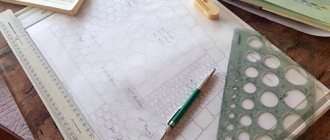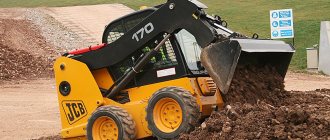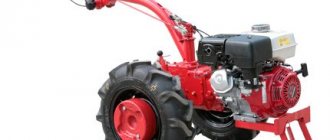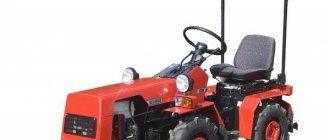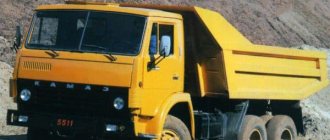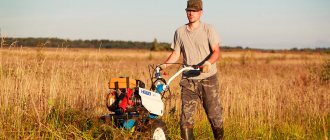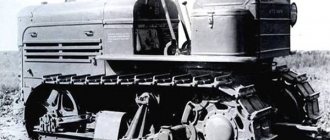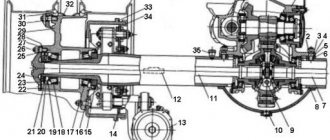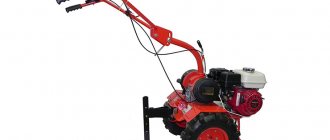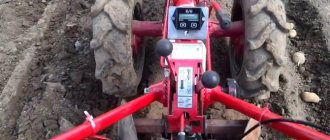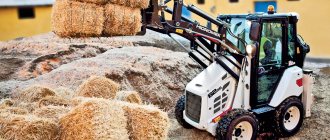With the arrival of spring, the summer season traditionally opens. Work in the garden requires a lot of physical effort and time, so experienced summer residents use auxiliary equipment to make work easier. A cultivator is especially helpful in agricultural work. The device is designed for efficient and fast soil cultivation, and in large areas it becomes an indispensable assistant. In this article we will look at the main characteristics of this unit and give recommendations on how to choose the right cultivator for your garden.
What is a cultivator
A cultivator is a device for high-quality soil care. Previously, cultivators were more often used for production purposes, on large farms and agricultural areas. Now they are actively used at the household level - fortunately, the choice has become simply huge. The cultivator loosens the soil, removes weeds, forms smooth beds, levels the soil surface and mixes fertilizers efficiently. This is not only a convenient replacement for a regular shovel, but also a big time saver. Cultivators are equipped with star-shaped cutters, with the help of which plowing, loosening, aeration, hilling of soil, etc. occurs. After cultivation, the soil becomes soft and ready for sowing.
The cultivator is easy to operate if you know the features of its design and operating principle. The internal design depends on the type of cultivator and the specific work being performed.
It is important to distinguish a cultivator from a walk-behind tractor. The walk-behind tractor is a self-propelled unit, it is universal and more powerful. The scope of its application is extensive. The design of the walk-behind tractor includes a motor, transmission, chassis, and control panel. Cultivators (and motor cultivators) are more specific in functionality and easier to use.
The main components of any cultivator:
- frame;
- rearward retractable control handle;
- steel beams;
- 1,2 or 3 wheels;
- rotor for connecting cutters of different functionality;
- brackets for attaching openers or other attachments;
- cultivation device;
- engine (electric, gasoline);
- tank for filling fuel.
Most models can be handled by one person without any help; even ultra-light cultivators have been developed for women. Manual models of cultivators are useful in private homes for plowing the garden area, caring for small beds and flower beds. More technologically advanced and multifunctional units are designed to process several hectares of soil at once in the shortest possible time. In addition, farmers use cultivators to loosen and level the soil in greenhouses. Greenhouse setups usually have limited space available, so a hand cultivator is definitely needed.
Plows
Plows are a soil cultivation technique that helps achieve a stable and good harvest. Plows are used in agricultural work to carry out basic soil cultivation.
The advantages of the unit include:
- promoting the accumulation of moisture in the soil, ensuring crop stability;
- no plant residues remain that could interfere with the operation of sowing equipment;
- intensive and effective loosening of the soil occurs;
- weed shoots, carrion and crop residues are buried deep into the ground;
- Fungal diseases of cultivated plants are effectively combated, and the concentration of weeds on the usable area of land is reduced.
Among the main disadvantages of plows are:
- before sowing, additional tillage is necessary;
- severe and rapid wear of equipment;
- high costs for mechanization;
- low productivity for a specific time of work;
- strong impact on the structure of the soil and the habitat of the organisms that live in it.
Experienced agricultural workers advise using the plow in such a way that the earthen layers are turned diagonally under the influence of the equipment. This will prevent seeding coulters from becoming clogged with plant residues, and will also minimize the risk of disrupting the processes of humus formation and mineralization.
Types of attachments
If you want to make your cultivator truly multifunctional, we recommend installing additional attachments on it. This equipment allows you to perform not only standard types of work such as plowing or loosening: with certain types of attachments you can hill up the soil, plant and harvest potatoes, cut furrows, and sow seeds. Some attachments are designed for tasks such as making hay, removing debris and snow. The use of attachments will save a lot of money, because you do not have to purchase separate equipment for various types of agricultural work.
Hinges can be divided into two types: active and passive. Active ones have moving parts that begin to work using the cultivator engine. The rotational energy of the engine is transferred to the linkage either with a belt drive or through a special power take-off shaft. Active type attachments include a snow blower, different types of mowers, and a sweeping brush. Passive attachments are not equipped with their own moving parts and are activated only by the movement of the cultivator itself. The most popular attachments of this type are a plow, a hiller, a potato planter, and a potato digger.
Let's look at the most useful and popular types of attachments among farmers.
Hitch
This is an auxiliary adapter element that allows you to attach any attachment to the cultivator. Without a hitch, you are unlikely to be able to install a plow or hiller.
Advice! As a rule, each specific model has its own individual coupling mechanism. It is therefore recommended that the operating parts of the hitch and the hitch be manufactured by the same manufacturer.
There are both universal hitches and hitches manufactured for a specific brand. Typically, the towbar is installed at one time using mounting brackets. Removing it is much easier; it is not necessary to use additional tools.
Hiller
An experienced farmer rarely does his work without it. The equipment facilitates hilling the soil, forms smooth ridges and an earthen ridge. Most often, the cultivator is equipped with a special hiller for potatoes. It is used for cutting even furrows and digging up root crops during the harvest period. There are hillers with dump plowshares (steel sheets) and disk hillers of the propeller type. Today, disc hillers are most in demand in agriculture; most modern manufacturers produce them. When performing its functions, this type of hiller encounters much less resistance from the ground. As a result, the load on the equipment and the lead operator is reduced. By adjusting the settings when installing the disc hiller, you can form earth ridges of different heights. At the same time, the earthen ridges are stronger and more stable than those of hillers with ploughshares. When creating a ridge, the latter pour part of the earth back into the furrow.
Disc hiller for cultivator
Plow
They are used for virgin soil during plowing, when it is necessary to turn over large layers of earth. The hitch is installed via a hitch or a special adapter. Nowadays, summer residents use one of two types of plows: standard and reversible. A conventional plow forms a moldboard in only one direction during operation. The reverse one, in turn, consists of two plows, therefore, soil dumps are carried out on two sides at once. With the help of the second type of plow, you can plow a large area of the site much faster and more efficiently.
Reversible plow
Potato planter
Purchasing this attachment will save you from the tedious and time-consuming procedure of planting potatoes. The planter is a complex unit consisting of a small plow, a hopper with a transport belt and a disc hiller. The plow forms a trench and prepares the soil for planting root crops. Seed material for planting is loaded onto the transport belt. The compact hiller loosens the soil and sprinkles the planted material.
This equipment is productive, but expensive. However, the potato planter fully justifies its price when cultivating a large number of hectares of land.
Potato digger
The main task of the hitch is to collect the finished crop. The design is similar to a hiller, but instead of steel blades it has long arms reminiscent of a broom. The principle of operation is simple: the rays dig up the surface of the soil, the soil is thoroughly sifted, and the pulled out root crops are automatically thrown in the other direction. The attachment is fastened to the cultivator via a hitch.
Grain planter
As the name suggests, this attachment is used for planting seeds. Available in two variations: 2-row planter and 4-row. The hitch is a complex consisting of a hopper for seed material, a calibration disk, and a small plow for cutting furrows. To prevent the planter from slipping, a steel lug is installed in the rear part of it.
Additional garden equipment
Additional automated devices for dachas are designed to make the work of amateur gardeners easier: cultivating the land, caring for plants, planting, plowing, weeding, caring for lawns and plantings. Equipment options for working on a personal plot:
- verticutters powered by a gasoline engine to clear the ground of plant roots and last year’s old leaves;
- scarifiers, clearing beds and lawns from last year’s debris, carrying out aeration work to enrich the soil with oxygen;
- aerators that feed the top layer of soil, saturating it with oxygen and useful components;
- self-propelled wheelbarrows for transporting goods up to 220 kg;
- mini tractors for plowing, weeding and planting.
Mowing grass: description, equipment and technique
Note! A mini tractor is a smaller copy of a real tractor with the ability to perform various types of tasks in small garden areas: weeding, plowing, plowing and loosening the soil, lawn care, sowing seeds, transporting goods.
How to choose a cultivator for your garden
Not all cultivators are universal and suitable for all types of agricultural work. If you want to buy a unit that is best suited for you, we recommend that you rely on the basic selection criteria. The fact is that each cultivator model has parameters that determine functionality, performance and service life.
Power
This parameter affects the area of the cultivated area and the productivity of the cultivator. Measured in horsepower or kW. The maximum power rating for modern models is up to 7 hp. or 5.2 kW. Assess the scope of the proposed work and the area of the entire household. Small areas do not require a unit with a high power rating, while plowing a spacious area can only be done with a powerful unit.
- For soil care in greenhouse installations and the formation of beds in the country, a unit power of 1-2 hp is sufficient. or 0.6-1.5 kW.
- For a medium-sized summer cottage (7-10 acres), the power of 4 hp is more than enough. or up to 3 kW.
- Huge farm areas are plowed using cultivators with a power of 6-7 hp. or 4-5 kW.
Plowing width
The available width of the cultivated area can vary from 18 to 105 cm. The larger the plowing width, the less distance you will need to cover to cultivate a specific area.
- The indicator 18-35 cm is optimal for caring for flower beds, processing narrow beds in a greenhouse or in a vegetable garden. A working width of no more than 35 cm will ensure the maneuverability of the device and allow it to be carried into hard-to-reach places.
- If you have to cultivate a spacious area and work in the field, choose a unit with maximum working widths (from 70 to 105 cm).
Plowing depth
The quality of loosening or hilling of the soil depends on the depth of cultivation. Cultivators vary greatly in plowing depth within the following range: from 11 cm to 35 cm.
- Models with a minimum plowing depth will prepare the soil for planting crops with a weak root system. Optimal for small beds.
- An average of 15 to 20 cm will allow you to loosen and hill up hard soil, preparing it for planting root crops.
- Cultivators with peak values (30-35 cm) are suitable for cultivating virgin lands, combating a large number of weeds, as well as for planting crops with powerful and strong roots.
Number of speeds
Cultivators differ in the number of speeds and direction of movement. There are four options in total.
- One speed forward: standard plowing of the area where you will need to manually pull the plow out when you reach the edge. A unit with 1 speed will be better handled by people with excellent physical fitness. Such models are recommended for use in small greenhouses, greenhouses, and narrow elongated beds.
- Two speeds: one forward and one reverse. Models with reverse gear come in handy when loosening the edges of a site. At any time you can turn around and continue cultivating the land in the next strip or ridge.
- Four speeds: two forward and two reverse. With such models you will provide even greater maneuverability and mobility. By rotating the cutters at different speeds (forward and reverse), you can quickly and effectively shake off entangled roots, long stems and debris. Ideal for virgin soil and areas where unwanted weeds grow fertilely.
- Four speeds: three forward and one reverse. This is a multifunctional cultivator. In essence, it does several useful things at the same time: it loosens the soil at idle or very low speeds, cuts furrows and methodically forms small beds for seed material. If the need arises, the device reverses and begins processing the soil along a new trajectory.
Device weight
You can choose a cultivator model based on the above weight classification. The weight of the unit affects its power, functionality, and additional capabilities. The weight indicator ranges from 7 (mini-cultivators) to 93 kg (professional tools).
Advice! If you regularly work in a small garden area, it is enough to purchase a model no heavier than 15 kg. Plowing on an industrial scale requires heavy-duty equipment with the ability to attach attachments and trailers.
engine's type
A fuel engine (usually gasoline) is not the most environmentally friendly option, as the process produces exhaust gases. In addition, they are very noisy. But if you need to plow the soil deeply, extract powerful weed roots from the soil and grind compressed layers of earth, this option is for you. Whatever one may say, the fuel engine provides maximum performance.
The electric motor is more environmentally friendly, but less powerful. Power is supplied from the mains or battery. Among the advantages: it does not make noise, weighs little, does not require additional maintenance in the form of purchasing fuel.
Using a motor cultivator on an uncultivated area
The cultivator is convenient on developed land; when working in overgrown areas, it can overheat and burn out
The most powerful motor cultivators are suitable for effective cultivation of virgin land, and they are not cheap. A heavy and powerful cultivator is needed to break through the turfy soil and plow it deeply.
Typically, treatment of a neglected area, even with powerful machines, is carried out in two stages:
- Using special cutters that are installed on a motor-cultivator, they cut off the top layer of soil to a depth of 10-15 cm. The entire root system of vegetation is intertwined in it. If this is done in the fall, the layer of soil turned upside down will freeze well in winter. And in the spring, weeds will have less chance to grow.
In the summer, during rapid growth, the grass can be treated with herbicides that will penetrate the roots and destroy them.
Two weeks after treatment, when the grass turns yellow, the top layers of soil with the root system are cut off and turned over with a milling cutter. In the sun, all the vegetation will dry out, and if left for the winter, it will also freeze. Dried grass and roots that have lain under the snow during the winter will be a good fertilizer.
- After destroying the weeds, for the normal development of crops, it is necessary to plow the soil to a depth of 20-25 cm. For example, growing potatoes using Dutch technology requires careful leveling of the soil, and the depth of its cultivation must be at least 30 cm.
Only heavy and powerful motor cultivators are suitable for this mission. Lightweight models are designed for cultivating soil to a depth of no more than 20 cm. They will not cope with dense turfy soil. Attempts to cultivate virgin soil with a cultivator can lead to engine overheating and costly repairs.
What is the difference between a motor-cultivator and a walk-behind tractor?
If you are choosing equipment for your dacha, then elaborating this issue should be key for you. Otherwise, you can buy something that is not at all suitable for your site and your physical and material capabilities. So, let's look at the points.
- In most cases, the cultivator only loosens the soil. The walk-behind tractor is much more functional.
- The walk-behind tractor will always be heavier and more powerful.
- The walk-behind tractor moves on wheels. A cultivator most often only has cutters for plowing (loosening) the soil. Due to their rotation, this unit moves forward. However, some models are equipped with wheels, but they do not play a leading, but rather a supporting role.
Criteria for selecting agricultural machinery
When choosing equipment for cultivating soil for spring plants or winter crops, you need to consider:
- what kind of work is agricultural machinery needed for?
- its dimensions and method of attachment to the tractor;
- traction tractor power;
- possibility of installing additional units;
- difficulty of maintenance and maintainability;
- work resource.
The modern agricultural market offers a wide range of tillage equipment. We invite readers to familiarize themselves with the list of the main types of land cultivation units. With its help, you can choose the optimal machine option, the operating parameters of which will fully correspond to the characteristics of the soil on the site, technology and level of crop rotation. The content of the article:
